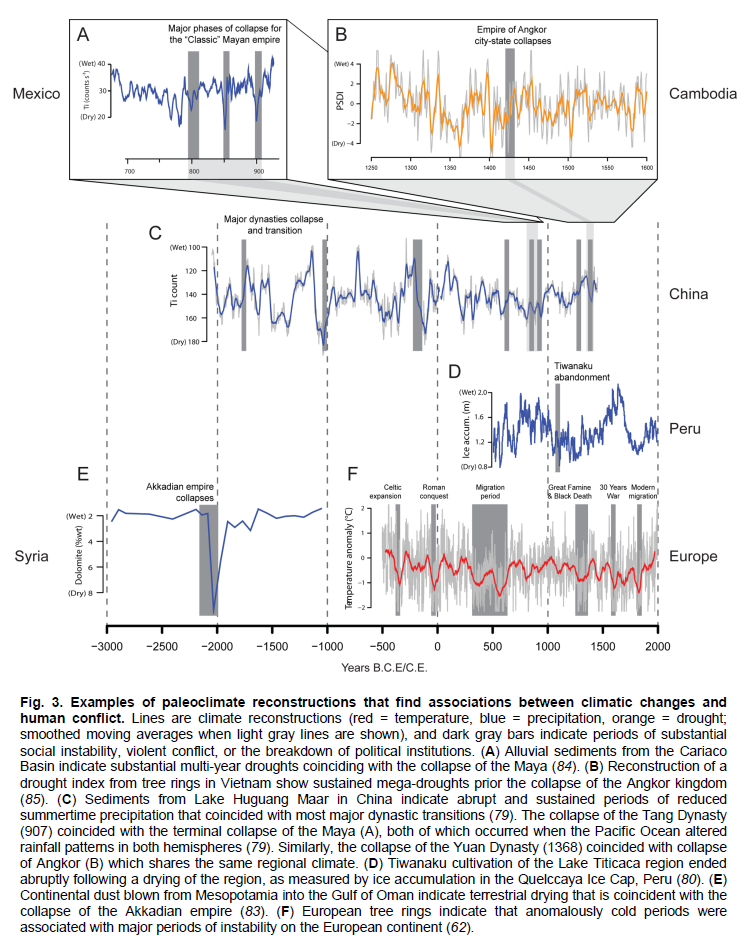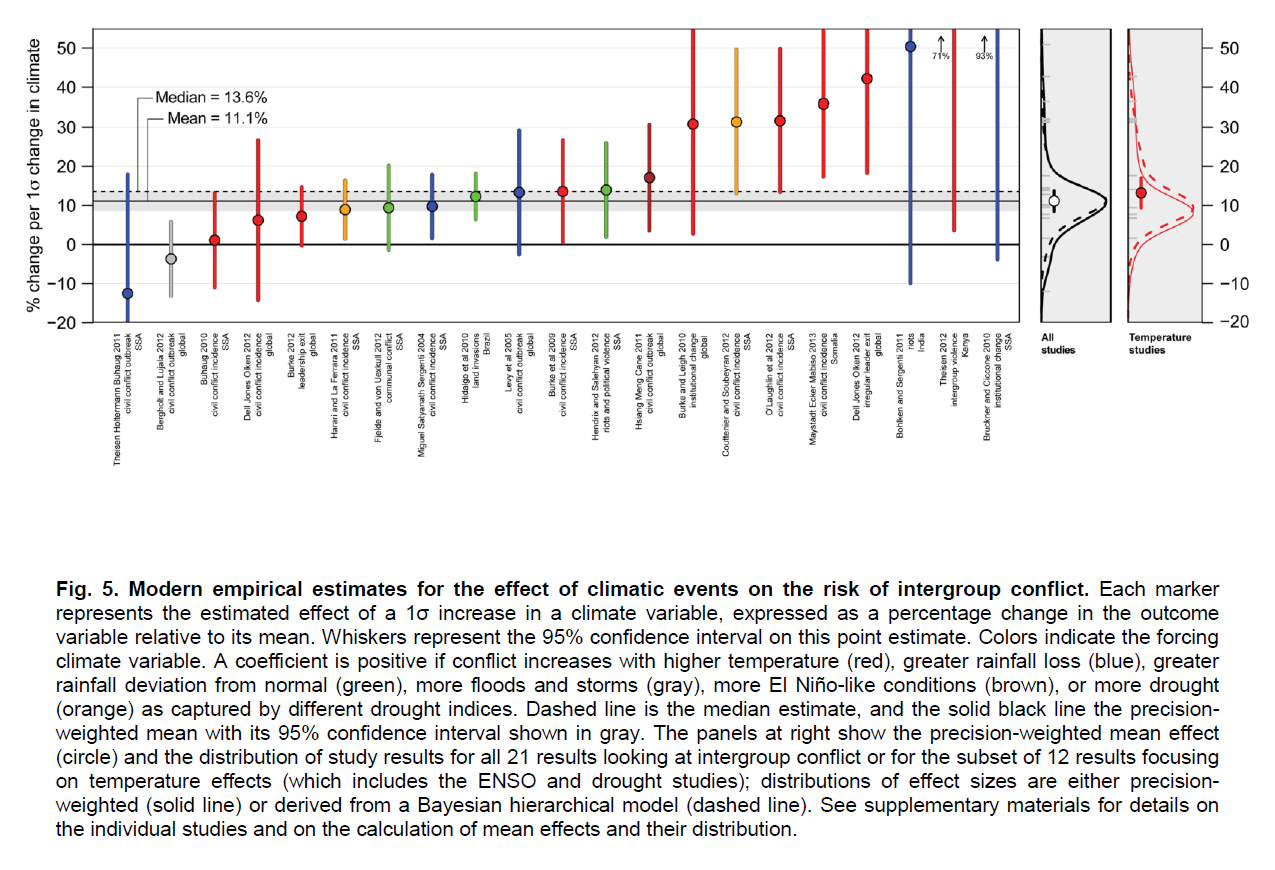-
Why Do Climate Changes Lead to Conflict? Provocative New Study Leaves Questions
September 12, 2013 By Josh Busby
In August, Solomon Hsiang, Marshall Burke, and Edward Miguel published a provocative piece in Science in which they sought to demonstrate a correlation between climate extremes and violence across a range of time periods, countries, and different levels of conflict. It’s a massive undertaking and one that predictably has evoked some criticism – some of it warranted.
“The magnitude of climate’s influence is substantial,” they report: “For each one standard deviation change in climate toward warmer temperatures or more extreme rainfall, median estimates indicate that the frequency of interpersonal violence rises 4 percent and the frequency of intergroup conflict rises 14 percent.”
They followed this up with an op-ed last week in The New York Times. Their claims are based on a re-analysis of the results of 60 other studies from different disciplines. They find that high temperature and extreme rainfall are correlated with a variety of forms of violence, from more baseball pitchers beaning batters on hot days (what they call “personal violence”) on up to civil conflict being more likely after extreme rainfall (i.e., “group-level violence” and “intergroup conflict”). They even document episodes of major civilizational collapse following sustained periods of weather anomalies (“breakdown of social order and political institutions”).
Their headline conclusion generated quite a bit of media coverage and response (if you want a non-exhaustive set of links to the coverage, see my post on The Duck of Minerva). Marshall Burke has replied to many critiques on the G-FEED blog, where he and Hsiang, among others, frequently write.
I appreciate both the ambition of Hsiang, Burke, and Miguel, and that they exercise some restraint and transparency. While in previous work, Burke, Miguel, and co-authors estimated future civil war battle deaths associated with climate change, the authors here have avoided such a contested exercise and merely encourage readers to draw their own conclusions based on their findings. They also acknowledge that they have not made an effort to nail down causal processes but identify some plausible ones.
That said, the criticism that has emerged particularly from political scientists has some merit (and indeed, I signed on to a comment article Halvard Buhaug circulated that may come out shortly in Science). Let me summarize what I think are among the major concerns that emerge from this line of critique.
Political Scientists Are Not That Interested in Personal Violence
 Many political scientists would question why one would include studies on personal violence in a wider assessment on the causes of civil war, particularly studies on the association between hot days and beaning episodes in baseball. While crime might not be as much of a stretch, many political scientists would nonetheless ignore or discount the findings of the 15 studies of “interpersonal violence” as not relevant to their core concerns about state-level violence and civil conflict.
Many political scientists would question why one would include studies on personal violence in a wider assessment on the causes of civil war, particularly studies on the association between hot days and beaning episodes in baseball. While crime might not be as much of a stretch, many political scientists would nonetheless ignore or discount the findings of the 15 studies of “interpersonal violence” as not relevant to their core concerns about state-level violence and civil conflict.Instead of 60 studies about the association between climate extremes and conflict, you then have 45 studies on broader political violence. For quantitative political scientists, the number actually reduces further to 35 since 10 of the 15 studies on institutional breakdown do not have statistical tests (though Figure 3 provides a nifty graphic of paleoclimate changes and major civilizational disturbances).
How Much Can We Learn From the Distant Past?
The authors include studies from the ancient period when polities were very different in terms of population levels, technology, and adaptive capacity. For example, the authors include a study that assesses the effect of flooding along the Nile on Egypt’s political stability between the 7th and 15th centuries and another study that documents the effects of droughts and floods on peasant rebellions in China between the 15th and 20th centuries. But it is unclear whether the impact of climate factors on past societies’ behavior is all that informative for thinking about climate change in the modern era.
Rainfall Abundance vs. Rainfall Scarcity
The authors look at standard deviations from means and thus treat different climate-related processes in a similar fashion, including extreme temperature, episodes of rainfall abundance, and rainfall scarcity (see their Figure 5 below).
But an emergent line of research suggests that rainfall abundance, rather than scarcity, may be a more potent trigger for certain forms of civil conflict since abundant rainfall may give actors more vegetative cover to hide in and launch attacks. More abundant rainfall may also raise the stakes since there are more resources to fight over (see Raleigh/Kniveton and Hendrix/Salehyan’s contributions to the January 2012 special issue of the Journal of Peace Research on climate and conflict, as well as this earlier Meier et al. piece).
The causal mechanisms piece of the article does not pick up on this important distinction, and indeed, their op-ed emphasizes scarcity as one of two main drivers of conflict in a way that I think most political scientists would find unsatisfying and unsupported by available evidence. They write:
In low-income countries largely dependent on agriculture – like those in much of sub-Saharan Africa and parts of Asia and Latin America – when the rains fail and temperatures scorch, crops wilt and die. This leaves many people dangerously close to the edge of survival, which can lead to social strife and even civil war.
Bundling rainfall abundance and scarcity under the same umbrella of extreme rainfall then potentially treats two quite different phenomena in the same way. It also obscures that the findings in the extreme rainfall space are actually quite a bit less consistent than for temperature. For example, of the 21 studies on inter-group conflict from the modern era, 8 do not find a statistically significant correlation between climate extremes and violence, by my reading. Of those, seven involve rainfall as the climate variable.
When and Why
Hsiang, Burke, and Miguel’s article reminds me of the debate about the “democratic peace” – the statistical finding that democracies almost never go to war with each other, first identified in a 1964 paper by Dean Babst, a criminologist who once worked for the Wisconsin State Department of Public Welfare. The democratic peace has been described as “the closest thing we have to an empirical law in the study of international relations.” Despite the seeming statistical robustness of the finding, the absence of a clear causal mechanism linking democratic foundations to peace sowed doubt among critics, even as policymakers seized upon the finding to encourage the spread of democracy everywhere.
Here we also have what could putatively be described as a finding in need of a theory, again generated outside the discipline of political science.
Different kinds of climate-related effects may exercise an influence on violence through different processes, and political scientists who write on climate and security are deeply engaged in efforts to isolate these causal mechanisms. Setting aside causal mechanisms is therefore problematic, as this gets to the heart of current debates.
The authors suggest that the climate-conflict finding is akin to the association between smoking and cancer that was initially identified in the 1930s in the absence of a detailed causal mechanism. With climate change, however, we are not dealing with medical effects inside the human body but the far more complex intersection of the physical, social, and political realms. While climate change is a meta phenomenon that may generate temperature increases and changes in rainfall, the effects are likely to be greatly varied across time and space precisely because of intervening factors associated with human systems.
As a consequence, there is far more to be gained by focusing on the diverse causal processes connecting climate effects and conflict – in short, when and why – rather than further exploring broad associations.
Josh Busby is an associate professor at the University of Texas Lyndon B. Johnson School of Public Affairs and one of the lead researchers for the Climate Change and African Political Stability project at the Strauss Center for International Security and Law. Follow him on Twitter at BusbyJ2.
Sources: The Duck of Minerva, G-FEED, Journal of Peace Research, The New York Times, Political Geography, Proceedings of the National Academy of Sciences, Science, The Violence of Nations.
Photo Credit: “AMISOM and Somali Troops Collaborate in a Anti-Shabaab Operation,” courtesy of Stuart Price/UN Photo. Chart Credit: Used with permission, courtesy of Science/Hsiang et al. (2013).
 A Publication of the Stimson Center.
A Publication of the Stimson Center.





